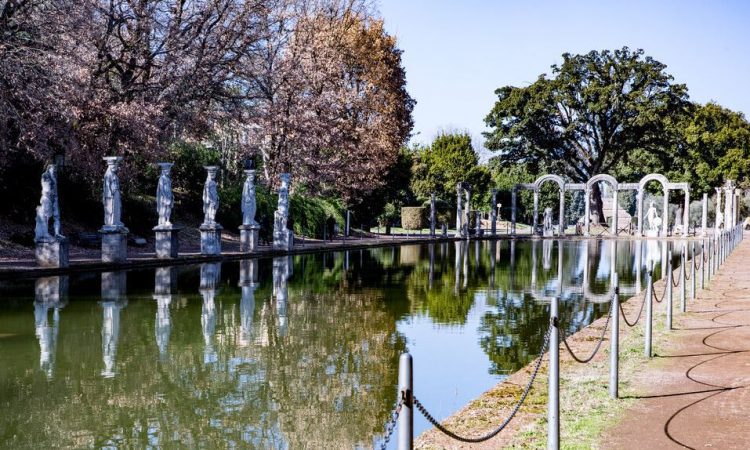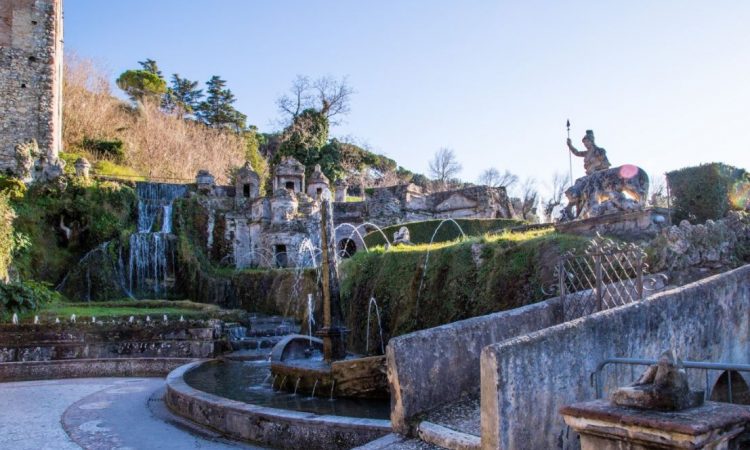Hadrian’s Villa and Villa d’Este in Tivoli
If you want a sneak peak into what life was like for the elite in both ancient and Renaissance times, then you must take a trip to explore the villas of Tivoli. There you will find the enormous retreat of the Emperor Hadrian, then skip forward in time 1300 or so years to discover one of Italy’s best renaissance gardens at Villa d’Este.

Tivoli
Ancient Tivoli (Tibur Superbum) has a much longer history than that of Rome as it dates all the way back to 1215 BC, at which time it was considered to be the meeting point of many different peoples. Nestled among the lush hills of the Lazio region about 30km north-east of Rome, Tivoli is home to the historic sites of Hadrian’s Villa and the Villa d’Este.

Hadrian's Villa
Emperor Hadrian ordered the construction of his 120 hectare hillside retreat in the 2nd century AD because apparently he wasn’t fond of the palace on Palatine Hill in the city of Rome. For wealthy rulers it was not uncommon to have villas commissioned as places to entertain guests and relax, though, none were quite like Hadrian’s Villa. He was so comfortable at his country retreat that it eventually became his permanent residence and during the later years of his reign he governed the Empire from the villa by hosting large numbers of visitors and bureaucrats; communicating with the offices in Rome via postal service.

Where villas were typically perched on hilltops, in the case of Hadrian’s Villa we find it laying on lower lands. This is because of the vast amount of water required to facilitate and fuel both the quantity and sheer size of the water features that are part of the grounds. We can find everything from baths and enormous pools to fountains, all of which were supplied from the same aqueducts that supplied water to Rome.

In addition to the impressive water features, the villa displays an interesting blend of architectural styles from Ancient Greece, Egypt, and Rome alike. Hadrian took inspiration from his travels when designing the principle features of his villa. One notable example is the Canopus. Used by the Emperor to host grand parties, the Canopus contains a large colonnaded pool bringing to mind a coastal resort of the same name near Alexandria. A smattering of Greek figures like Poikilos and the Grotto of Hades pay homage to the grecian places that Hadrian visited.

Other main features of the villa include the Maritime Theatre, also known as a villa inside a villa. It is a circular structure that contains a central atrium, protected by a moat. The Pecile, a huge garden surrounding a large swimming pool, and enclosed by an arcade. Originally, the pool was also surrounded by four walls with a colonnaded interior that served to support a roof. This area created a peaceful solitude for Hadrian and his guests.
Impressive as it is, Hadrian’s Villa is not the only noteworthy villa in Tivoli. Villa d’Este, built in the 16th century, is the pinnacle of Italian Renaissance Gardens and is famed for its fountains, channels, grottos, pools, jets, cascades, and water games.

Villa d'Este
The villa was commissioned by Cardinal Ippolito II d’Este, son of the Duke of Ferrara and grandson of Pope Alexander VI, after a failed bid at the papacy.
The villa itself is home to extensive Renaissance frescoes and sculpture, as well as ancient sculptures, many of which were in fact taken by Cardinal d’Este in the 16th century from what was Hadrian’s Villa.

However, the true mastery lies below in the cascading gardens. Here we find fountains and sculptures produced by the likes of Bernini, Raffaello Sangallo, Pirro Ligorio, and many others. Artistry aside, the marvel and glory of Villa d’Este comes from the expertly executed feats of hydraulic engineering that were required to design and build the extraordinary system of fountains.
The gardens are home to: 51 fountains and nymphaeum, 398 spouts, 364 water jets, 64 waterfalls, 1 water organ (that plays shows daily, every 2 hours from 10:30am), and 220 basins, fed by 875 meters of canals, channels and cascades, all working entirely by GRAVITY. That’s right, no pumps of any kind!!

Pirro Logorio, the architect responsible for the iconographic programs of the villa’s frescoes, was also commissioned to lay out the gardens for the villa, with the assistance of Tommaso Chirchi of Bologna who was one of the most skilled hydraulic engineers of the 16th century. The two men managed to figure out how to divert enough water from the Aniene through the town of Tivoli to supply some 500 jets, fountains, pools and water troughs.
The garden is now part of the Grandi Giardini Italiani and a protected UNESCO heritage site.



Recent Comments